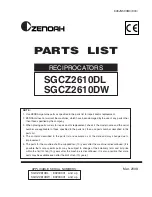
15
14
Additional safety instructions for circular saws with pendulum
guard-Low guard function
a.
Check the lower guard for proper closing before each
use
.
Do not operate the saw if the lower guard does not
move freely and close instantly. Never clamp or tie the
lower guard into the open position.
If the saw is accidentally
dropped, the lower guard may be bent. Raise the lower guard
with the retracting handle and make sure it moves freely and
does not touch the blade or any other part, in all angles and
depths of cut.
b.
Check the operation of the lower guard spring. If the guard
and the spring are not operating properly, they must be
serviced before use.
The lower guard may operate sluggishly
due to damaged parts, gummy deposits, or a build-up of debris.
c.
The lower guard may be retracted manually only for special
cuts such as “plunge cuts” and “compound cuts.” Raise
the lower guard by retracting the blade guard lever and
as soon as the blade enters the material, the lower guard
must be released.
For all other sawing, the lower guard should
operate automatically.
d.
Always observe that the lower guard is covering the
blade before placing the saw down on bench or floor.
An unprotected, coasting blade will cause the saw to walk
backwards, cutting whatever is in its path. Be aware of the time
it takes for the blade to stop after switch is released.
Saw blade safety warnings
To avoid overheating the blade tips:
•
Use only blades recommended which comform to EN847-1.
•
Pay attention to the maximum rotation speed. Never exceed the
maximum speed indicated on the blade.
•
Never use damaged or dull blades. You are not authorized to
repair the blade.
• Use the provided blade for cutting wood only, never cut metal or
plastic.
•
If you working for long periods, the blade may overheat. Take
15 minutes pause to let the blade cool down.
a. Only use saw blades if you have knowledge of how to use and
handle them.
b. Only use saw blades that are marked with a speed equal or
higher than the speed marked on the tool.
c. Do not use working saw blades which are cracked. Scrap saw
blades whose bodies are cracked. Repairing is not permitted.
d. Clamping surfaces shall be cleaned to remove dirt, grease, oil
and water.
e. Do not use loose rings or sleeves to «make up» bore sizes on
saw blades.
f. Open the lower guard and remove the saw blade to clear the
inside of the lower and upper guards if necessary. Remove
stubborn dirt with high pressure air (max. 3 bar).
g. Ensure fixed rings are parallel to each other.
h. Handle saw blades with care. Store them in the original
packaging or in special boxes. Wear gloves for handling and to
reduce injuries.
i. Check the function of the lower guard by raising and releasing
the retraction lever. Ensure all guards function well before using
saw blades.
j. Before use, make sure that the saw blade complies with
technical requirements of the power tool and is correctly fixed.
ADDITIONAL SAFETY WARNINGS FOR BATTERY
a.
Do not connect the positive terminal and negative terminal of
the battery to each other with any metal object (such as wire).
b.
Do not carry or store battery together with necklaces, hairpins
or other metal objects.





































